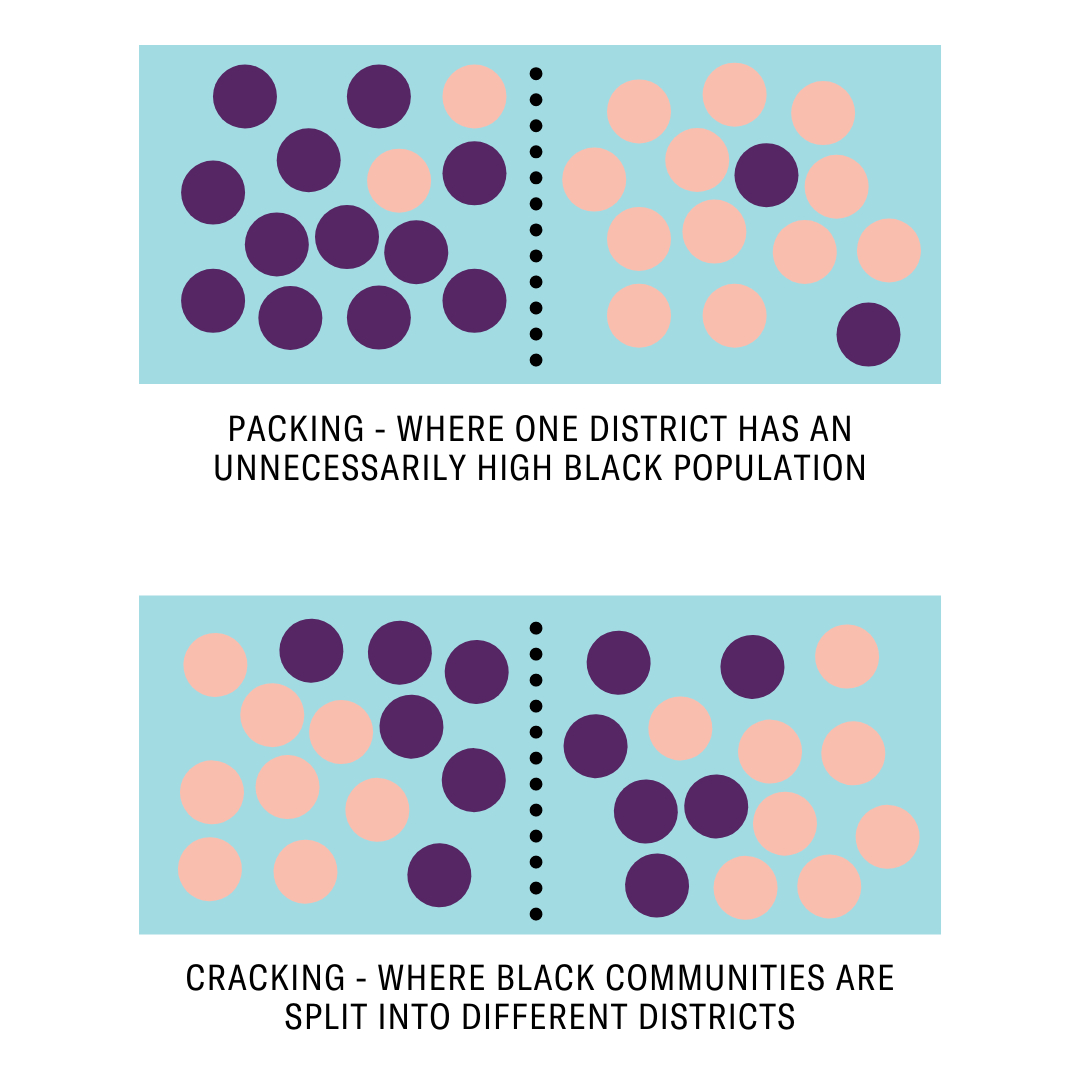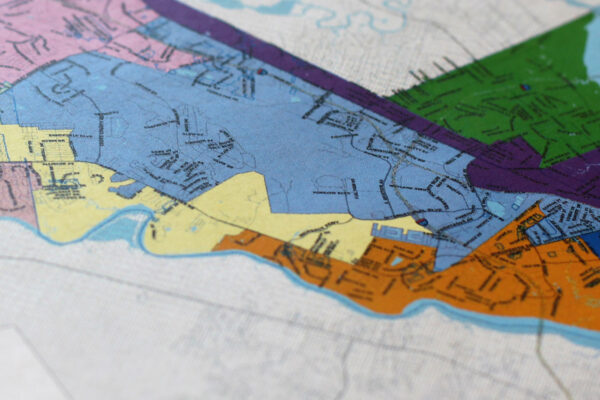Redistricting: Fair Maps for Alabama
Update: Governor Kay Ivey called the special session on reapportionment to begin on Thursday, October 28. On October 19, the ACLU of Alabama, along with the ACLU, NAACP Legal Defense and Educational Fund, Alabama State Conference of the NAACP, and Greater Birmingham Ministries, sent a letter to the Alabama Reapportionment Committee with an overview of their legal obligations during the redistricting process. Find out more and read the full letter here.
The right to vote is one of the most sacred civil liberties we have as citizens. We believe voting should be easy for every citizen and that each vote should count the same.
Historically, politicians have used gerrymandering, packing, and cracking to dilute the influence of Black voters. We seek to ensure that the current redistricting process allows Alabama's Black voters the same opportunities as white voters to elect their candidates of choice, regardless of where they live in the state and regardless of who they vote for.
Redistricting is not something best left to the politicians and the experts. Every voter has a vital stake in redistricting because it determines the composition of districts that elect public officials at every level of government.
NOT SURE WHICH DISTRICT YOU CURRENTLY LIVE IN? FIND OUT HERE.
Redistricting 101: Dive in deeper on maps, the history, and how you can get involved.
FREQUENTLY ASKED QUESTIONS
Q: What is redistricting?
A: Every 10 years, including this year, states redraw electoral district lines based on population data gathered in the Decennial Census. These district lines determine the electoral boundaries for representation in Congress, state legislatures, and in many county and municipal offices. This process is called 'redistricting.'
Q: What is gerrymandering?
A: Sometimes, people talk about how redistricting can be used to ‘gerrymander’ these electoral district lines. Gerrymandering is the practice of manipulating electoral boundaries to give an unfair political advantage to a particular political party or group.
In racial gerrymandering, state legislatures use race as a predominant factor in drawing districts and do so in a way that is not justified by the Voting Rights Act. This process often dilutes the influence of voters of color. One method involves “packing” communities of color into a small number of districts to weaken their voting power, when they would otherwise be an influential voting block across multiple districts. Districts can also be drawn to reduce the voting power of a minority group by “cracking” the community into several districts that are overwhelmingly white.
Q: What are ACLU of Alabama’s biggest concerns regarding redistricting?
A: Fairness. Legislators must not draw maps that artificially “pack” Black voters into some districts or “crack” Black voters across districts with the intent or effect of diluting voting strength, without analyzing what the Voting Rights Act actually requires. The Committee must also follow the Alabama Constitution’s command to respect county lines except where necessary to comply with the Voting Rights Act or one-person, one-vote. Unnecessarily splitting districts across counties dilutes voters’ power by creating legislative delegations that do not prioritize that county’s constituents. This practice disproportionately denies Black Alabamians local influence.
Transparency. Fair maps require that legislators conduct the redistricting process transparently, and take public input into account. The committee should publicize notice of hearings and instructions for public participation, hold additional hearings to include evening and weekend hours, ensure that hearings are held in locations people with mobility impairments can access, and provide American Sign Language interpreters at each hearing and make it easy for participants with disabilities to request additional accommodations.
Q: What does the Voting Rights Act require when it comes to redistricting?
To provide voters of color with an equal opportunity to elect their preferred candidates, Section 2 of the Voting Rights Act prohibits states from drawing electoral lines with the intent or effect of diluting minority voting strength.
Accordingly, the Reapportionment Committee must ensure that any maps it draws or produces comply with the “One Person, One Vote” mandate of the Fourteenth Amendment’s Equal Protection Clause and Section 2’s “nationwide ban on racial discrimination in voting,” without using either as a pretext to engage in racial gerrymandering.
With preclearance in place, the U.S. Department of Justice cited over 100 objections of “discriminatory changes in voting practices or procedures in Alabama," including at least 16 objections to proposed state or local redistricting plans that would have violated the Voting Rights Act.
Q: Why should this matter to the Reapportionment Committee?
Thanks to the Supreme Court's decision in Shelby County v. Holder, originally filed here in Alabama, this will be the first redistricting cycle without the protections of Section 5 of the Voting Rights Act, which had played a critical role in safeguarding against plans that made voters of color worse off than the existing plans.
Without preclearance, the Reapportionment Committee must affirmatively facilitate a redistricting process that complies with federal mandates in force, including Section 2 of the Voting Rights Act and the Fourteenth and Fifteenth Amendments’ prohibitions on racial discrimination.
Because of Alabama’s stark patterns of voting along racial lines, the Reapportionment Committee and legislature must carry out their obligations under Section 2 of the Voting Rights Act affirmatively in drawing maps, not merely as an afterthought after maps are drawn. At minimum, any maps that this body adopts must preserve any effective districts that are VRA-compliant and also consider whether additional effective opportunity districts are required.
Q: What is "packing" and "cracking"?
The U.S. Constitution protects against maps that intentionally "pack" or "crack" Black voters — both techniques employed by Alabama in the past to diminish the political power of Black people.

The Black populations in effective Black districts such as Congressional District 7 and in certain state legislative districts must not be cracked such that Black voters can no longer elect candidates of choice in any district in the State; but they also must not be artificially inflated beyond what is necessary for VRA compliance, which could violate the U.S. Constitution.
For example, in the State Legislature, current maps offer evidence of significant unnecessary packing of Black voters into several districts in the Montgomery and Birmingham areas in ways that do not reflect communities of interest and are well beyond the thresholds necessary for Black voters to elect candidates of choice.
By contrast, Huntsville’s Senate districts are currently cracked in a way that artificially dilutes Black voting opportunity. These uses of race are not narrowly tailored to comply with the VRA but rather unnecessarily and improperly dilute Black voting strength in neighboring districts.

HOW TO GET INVOLVED
LEARN NEXT STEPS FOR THE STATE OF ALABAMA.
Alabama Governor Kay Ivey called a special legislative session for redistricting to allow the Alabama Legislature to draw new congressional, state legislative, and state board of education districts. The special session was gaveled in on October 28, 2021. Check out our FAQ for the special session here.
SUBMIT COMMENTS TO COMMITTEE MEMBERS.
Let them know why fair maps are important to you and your community.
Access further information from the Permanent Legislative Committee on Reapportionment, including the state's proposed maps, member information, meeting notices and transcripts, and more.
|
|
Senate |
House |
|---|---|---|
|
1st Congressional District |
Jack Williams, [email protected] |
Sam Jones, [email protected] |
|
2nd Congressional District |
Jimmy Holley, [email protected] |
Steve Clouse, [email protected] |
|
3rd Congressional District |
Jim McClendon, [email protected] |
Barbara Boyd, [email protected] |
|
4th Congressional District |
Clay Scofield, [email protected] |
Kyle South, [email protected] |
|
5th Congressional District |
Steve Livingston, [email protected] |
Lynn Greer, [email protected] |
|
6th Congressional District |
Dan Roberts, [email protected] |
Corley Ellis, [email protected] |
|
7th Congressional District |
Gerald Allen, [email protected] |
Chris England, [email protected] |
|
At Large |
Tim Melson, [email protected] |
Laura Hall, [email protected] |
|
At Large |
Arthur Orr, [email protected] |
Randy Wood, [email protected] |
|
At Large |
Bobby Singleton, [email protected] |
Joe Lovvorn, [email protected] |
|
At Large |
Rodger Smitherman, [email protected] |
Chris Pringle, [email protected] |
ASK QUESTIONS.
In general
- What are your primary redistricting goals? What are the criteria you’re using for achieving those goals?
- How are you weighting your redistricting guidelines? Which are your top priorities among competing priorities?
- What are the most significant changes from the existing maps that you anticipate?
- Are you using total population, Voting Age Population (VAP), Citizen Voting Age Population (CVAP), or something else as your base population metric?
- How will incarcerated people be counted? Will incarcerated people be treated as residing where they are incarcerated, where they previously lived, or excluded from redistricting?
Transparency
- How is this public hearing going to affect your redistricting process?
- In what ways will you make your decision-making process public?
- What different ways will the public be ablehave to submit input? Can the public submit comments on drafts, or map proposals of our own?
- How much time will be provided for public input between draft and final maps adopted by the legislature?
Section 2 compliance
- Has the committee determined the level of Black Citizen Age Voting Population (BCVAP) needed for Black voters to have an opportunity to elect their candidate of choice where voting is racially polarized in different jurisdictions?
- What analysis has the committee undertaken to determine the BCVAP needed to effectively elect candidates of choice?
- Has the Committee undertaken this analysis at the local level?
- What does the Committee believe is necessary to do to comply with the Voting Rights Act in drawing congressional or state legislative districts?
Undue partisanship
- Does the Committee intend to draw maps with the intent to favor one political party?
- Race and party are closely correlated in Alabama. How will you ensure that politically gerrymandered maps do not also favor voters according to race?
- How will political considerations apart from incumbency play a role in your decisionmakingdecision-making?
- What will you do to ensure that boundaries are not drawn for a purpose of favoring or disfavoring a particular political party?
Protecting historically disenfranchised communities
- What are you doing to ensure that communities of interest stay intact, such as certain Black communities in Birmingham and Huntsville?
- Will you reunite any of the following communities of interest that are split in the current maps?
- What will you do to ensure that boundaries are not drawn for purposes of favoring or discriminating against a minority group?
Splitting counties
- What criteria will you use to determine when to split counties and voting precincts?
- Are there any situations in which you would split counties or voting precincts beyond the goal to meet equal population goals?
- Speakers can demonstrate commonality and the need to preserve communities of interest by testifying to shared representation in or use of:
- Other political or judicial subdivisions (e.g., water districts, fire and police districts, the jurisdictions of local courts)
- Educational opportunities (school districts, the areas served by local colleges, community colleges, and vocational schools)
- Religious congregations
- Employment opportunities (e.g., most of the workers at an auto plant, warehouse, or slaughterhouse reside in this region)
- Other services (the regions connected by certain highways and roads, regions served by the same hospital, airport, or railways).]
Congressional concerns
- How will the committee correct what the state has conceded is a racial gerrymander? [See Defs.’ Pretrial Brief at 11, Chestnut v. Merrill, No. 2:18-CV-00907-KOB, ECF No. 101 (N.D. Ala. Oct. 28, 2019)]
- Will the Committee agree to keep Montgomery in one district rather than spitting it between three?
- Will the Committee consider using Birmingham and Jefferson County as the anchor of a district rather than splitting it into two?
Page last updated: October 28, 2021
Related Content


